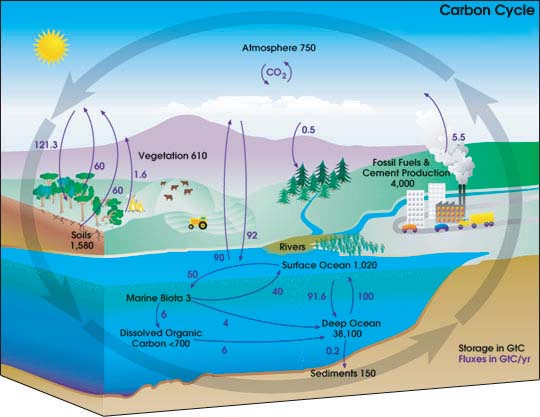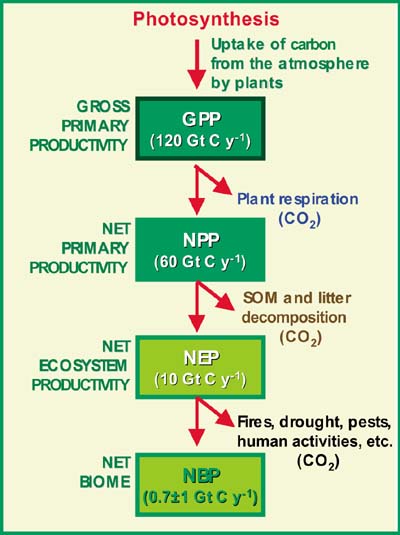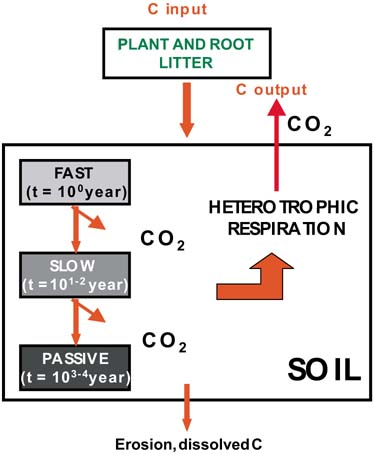The concentration of carbon dioxide (CO2) in the atmosphere increased from 285 ppm at the end of the nineteenth century, before the industrial revolution, to about 366 ppm in 1998 (equivalent to a 28-percent increase) as a consequence of anthropogenic emissions of about 405 gigatonnes of carbon (C) (± 60 gigatonnes C) into the atmosphere (IPCC, 2001). This increase was the result of fossil-fuel combustion and cement production (67 percent) and land-use change (33 percent). Acting as carbon sinks, the marine and terrestrial ecosystems have absorbed 60 percent of these emissions while the remaining 40 percent has resulted in the observed increase in atmospheric CO2 concentration. Figure 1 presents the different carbon pools and fluxes of the global carbon balance.
Land-use change and soil degradation are major processes for the release of CO2 to the atmosphere. The increase in greenhouse gases (GHGs) in the atmosphere is now recognized to contribute to climate change (IPCC, 2001). Although uncertainties remain regarding the causes, consequences and extent of climate change, it is believed that human activities are having an impact on the energy balance of the earth. Its influence on the climate is a major concern in the twenty-first century. This concern has led to the 1997 international agreement in Kyoto (the so-called Kyoto Protocol), whereby most countries are committed to reducing their GHG emissions to the atmosphere. In this context, new strategies and policies within the international framework have been developed for the implementation of agriculture and forestry management practices that enhance carbon sequestration (CS) both in biomass and soils. These activities are included in Articles 3.3 and 3.4 of the Kyoto Protocol (KP) and are known as “land use, land-use change and forestry” (LULUCF) (IPCC, 2000).
FIGURE 1 Major carbon pools and fluxes of the global carbon balance

The importance of these activities is that any action taken to sequester C in biomass and soils will generally increase the organic matter content of soils, which in turn will have a positive impact on environmental, agricultural and biodiversity aspects of ecosystems. The consequences of an increase in soil carbon storage can include increases in soil fertility, land productivity for food production and security, and prevention of land degradation. Therefore, they might constitute win - win situations.
A proper analysis of the impact of climate change must also consider other global concerns such as loss of biodiversity, changes in land use, growing food demand, and soil degradation. International United Nations conventions exist regarding these problems: the Convention on Biological Diversity (CBD), the Convention to Combat Desertification (CCD), the Ramsar Convention of Wetlands, and there are also several related United Nations programmes, e.g. the United Nations Environment Programme (UNEP), and the United Nations Development Programme (UNDP). Other initiatives, such as the Millennium Ecosystem Assessment, funded internationally by the World Bank, the United Nations Global Environment Facility (GEF), etc., aim to determine the state of the earth’s ecosystems, trying to take into consideration all global problems and the interactions among them.
To help understand the concept of CS, Figure 2 presents a simplified diagram of the carbon balance of terrestrial ecosystems. The main entry of C into the biosphere is through the process of photosynthesis or gross primary productivity (GPP), that is the uptake of C from the atmosphere by plants. Part of this C is lost in several processes: through plant respiration (autotrophic respiration); as a result of litter and soil organic matter (SOM) decomposition (heterotrophic respiration) and as a consequence of further losses caused by fires, drought, human activities, etc.
FIGURE 2 Terrestrial global carbon balance (simplified)

Source: Adapted from IPCC (2000).
Currently, the biosphere constitutes a carbon sink that absorbs about 2.3 gigatonnes of C per year, which represents about 30 percent of fossil-fuel emissions. The increasing atmospheric CO2 concentration stimulates the process of photosynthesis (currently substrate-limited) and consequently plant growth, as extensive experimental research has shown (IPCC, 2000). The extent of this stimulation varies according to different estimates, being larger for forest (up to 60 percent) and smaller for pastures and crops (about 14 percent). Current scientific evidence suggests that managed and mature oldgrowth forests act as active carbon sinks sequestering C at rates of up to 6 tonnes/ ha/year (for boreal and temperate forests) (Valentini, Matteucci and Dolman, 2000).
However, forests and ecosystems in general may have a limited capacity to accumulate C. First, this is because the capacity to sequester C is limited by other factors, such as nutrient availability (Oren, Ellsworth and Johnsen, 2001) and other biophysical factors. Second, photosynthesis may have a CO2 saturation point, above which it will no longer respond to an increase in atmospheric CO2 concentration. A third reason is that climate change may lead to ecosystem degradation, in turn, limiting the capacity to sequester C. Although much scientific progress has been made recently, these processes are still poorly understood. Therefore, predictions of more than a few decades are highly uncertain. Furthermore, forests in the absence of disturbances are expected to take up C for 20 - 50 years after establishment and, therefore, they should be considered as a time-buyer until other technologies are developed to reduce emissions.
Many scientific issues regarding the global carbon cycle remain unresolved or uncertain, such as the contribution of oceans to the global carbon balance (Del Giorgio and Duarte, 2002), the contribution of rivers (Richey et al., 2002), and the interaction with other biogeochemical cycles (Schimel, 1998). The switch of the terrestrial biosphere from its current role as a carbon sink to a carbon source is highly controversial, as it is based on the long-term sensitivity of the respiration of soil microbes to global warming. Long-term predictions using bioclimate models yield different results depending on the temperature sensitivity function used for heterotrophic respiration. One of these simulations indicated that the absorption capacity of the biospheric carbon pool was approaching its limit, and that forests would turn into sources after 50-150 years (Cox et al., 2000). Other findings suggest that, based on long-term soil warming experiments in the boreal zone, heterotrophic respiration is not very sensitive to increases in temperature, and that, therefore, the future of carbon sinks could be maintained (Falkowski, Scholes and Boyle, 2000). Global warming could lead to an increase in heterotrophic respiration and decomposition of organic matter, and consequently to a decline in the sink capacity of terrestrial ecosystems (Schimel, House and Hibbard, 2001). Further research is needed before any sound conclusions can be reached.
Although strategies to sequester C may be welcome, the use of CS options should not distract from the goal of reducing dependence on fossil fuel, the cause of the problem in the first place. CS should not be seen as a way to substitute the need and motivation to utilize energy efficiently and to use renewable energy. Rather, CS should be seen a good thing per se and as a bridge until other acceptable and environmentally friendly alternatives are found.
FIGURE 3 Soil carbon balance (simplified)

Soils are the largest carbon reservoir of the terrestrial carbon cycle. The quantity of C stored in soils is highly significant; soils contain about three times more C than vegetation and twice as much as that which is present in the atmosphere (Batjes and Sombroek, 1997). Soils contain much more C (1 500 Pg of C to 1 m depth and 2 500 Pg of C to 2 m; 1 Pg = 1 gigatonne) than is contained in vegetation (650 Pg of C) and twice as much C as the atmosphere (750 Pg of C) (see Figure 1). Carbon storage in soils is the balance between the input of dead plant material (leaf and root litter) and losses from decomposition and mineralization processes (heterotrophic respiration) (Figure 3). Under aerobic conditions, most of the C entering the soil is labile, and therefore respired back to the atmosphere through the process known as soil respiration or soil CO2 efflux (the result of root respiration - autotrophic respiration - and decomposition of organic matter - heterotrophic respiration). Generally, only 1 percent of that entering the soil (55 Pg/year) accumulates in more stable fractions (0.4 Pg/year) with long mean residence times.
TABLE 1
Agricultural practices for enhancing
productivity and increasing the amount of carbon in soils
|
Traditional practices |
Recommended |
|
Plough till |
Conservation till or no-till |
|
Residue removal or burning |
Residue return as mulch |
|
Summer fallow |
Growing cover crops |
|
Low off-farm input |
Judicious use of fertilizers and integrated nutrient management |
|
Regular fertilizer use |
Soil-site specific management |
|
No water control |
Water management/conservation, irrigation, water table management |
|
Fence-to-fence cultivation |
Conversion of marginal lands to nature conservation |
|
Monoculture |
Improved farming systems with several crop rotations |
|
Land use along poverty lines and political boundaries |
Integrated watershed management |
|
Draining wetland |
Restoring wetlands |
The process of soil CS or flux of C into the soil forms part of the global carbon balance. Many of the factors affecting the flow of C into and out of soils are affected by land-management practices. Therefore, management practices should focus on increasing the inputs and reducing the outputs of C in soils (Table 1). The change in soil carbon stock under different management practices is modelled for specific case studies in Chapter 5.
The long-term CS potential is determined not only by the increase of C inputs into the soil but also by the turnover time of the carbon pool where the C is stored. For long-term CS, C has to be delivered to large pools with slow turnover. The partitioning between different soil carbon pools with varying turnover times is a critical controller of the potential for terrestrial ecosystems to increase long-term carbon storage. Allocation of C to rapid-turnover pools limits the quantity of long-term carbon storage, as it is released rapidly back to the atmosphere.
A proper analysis of the CS potential of a specific management practice should consider a full carbon balance of the management practice if it is to be used for carbon mitigation purposes. Another problem is the cost of agricultural practices in terms of C. Application of fertilizers, irrigation and manuring are all common practices that consume C. Therefore, full carbon accounting should take into account all activities associated with a particular practice.
Furthermore, other GHG such as methane (CH4) and nitrous oxide (N2O) are influenced by land use. Although emitted in smaller amounts, they have a much larger greenhouse potential. Therefore, they should be quantified explicitly and included in the total balance. One kilogram of CH4 has a warming potential 23 times greater than 1 kg of CO2, over a 100-year period, while the warming potential of 1 kg of N2O is nearly 300 times greater (Ramaswamy, Boucher and Haigh, 2001). About one-third of CH4 emissions and two-thirds of N2O emissions to the atmosphere come from soils (Prather et al., 1995) and are related to agricultural practices.
SOM is a key indicator for soil quality, both economically, as it enhances plant productivity, and from an environmental point of view on account of CS and biodiversity. SOM is the main determinant of soil biological activity, which in turn, has a major impact on the chemical and physical properties of soils (Robert, 1996). The increase in SOM can improve: aggregation and the stability of soil structure; infiltration rate and water retention; and resistance to erosion.
Soil carbon storage is controlled primarily by two processes: primary production (input) and decomposition (output). Measurements of C storage in an ecosystem alone reveal little about how C has changed in the past or will change in the future. The effect of climate and/or land-use change can be predicted only through the use of accurate dynamic models. Modelling has been used as an effective methodology for analysing and predicting the effect of land-management practices on the levels of soil C.
A number of process-based models have been developed over the last two decades to fulfil specific research tasks. Each model varies in its suitability for application to new contexts. A number of comparisons between models have been made, in particular by Smith et al., (1997). The European Soil Organic Matter Network also provides a comprehensive description of many models currently available. Various models have been developed to simulate C dynamics in soils. SOM is very complex, formed of very heterogeneous substances and generally associated with minerals present in soils. The mean residence time of C in soils ranges from one or a few years (labile fraction) to decades and even to more than 1 000 years (stable fraction). The mean residence time is determined not only by the chemical composition of SOM but also by the kind of protection or bond within the soil. The stable carbon fraction is protected either physically or chemically. Physical protection consists of the encapsulation of SOM fragments by clay particles and microaggregates (Balescent, Chenu and Baladene, 2000). Chemical protection refers to specific chemical bonds between SOM with other soil constituents, such as colloids or clays. Different factors influence different pools. Given the complexity of the nature of SOM, most models describe soil organic carbon (SOC) as divided in multiple parallel compartments with different turnover times (Figure 3). Such compartment models are in principle conceptually simple and have been used widely. A good example is the Rothamsted SOC model that has five compartments: decomposable plant material, resistant plant material, microbial biomass, humus and SOM (Jenkinson and Rayner, 1977; Jenkinson, 1990). Another popular model is the CENTURY model (Parton et al., 1987; Parton, Stewardt and Cole, 1988) which also has carbon compartments with similar parameters. Although simple conceptually, the problem of these models is that they require information on the size and turnover rate of each compartment, which is difficult to obtain from field studies. However, they have provided useful information on the effect of temperature, moisture and soil texture on the turnover of C in soils. FAO has developed a model as a methodological framework for the assessment of carbon stocks and the prediction of CS scenarios that links SOC turnover simulation models (particularly CENTURY and Rothamsted) to geographical information systems and field measurement procedures (FAO, 1999). However, the real potential for terrestrial soil CS is not known because of a lack of reliable database and fundamental understanding of the SOC dynamics at the molecular, landscape, regional and global scales (Metting; Smith and Amthor, 1999). The lack of sound scientific evidence and the difficulty of carbon accounting have probably prevented the explicit inclusion of soils in the KP.
It has been speculated that improved terrestrial management over the next 50 - 100 years could sequester up to 150 Pg of C, the amount released to the atmosphere since the mid-nineteenth century as a result of past agricultural conversion of grasslands, wetlands and forests (Houghton 1995; Lal et al., 1998). If this figure were realistic, it would be a “buying time” for the development and implementation of a longer-term solution to the CO2 problem. Evidence for long-term experiments reveals that soil C losses as a result of oxidation and erosion can be reversed through improved soil management such as reduced tillage and fertilization (Rasmussen, Albrecht and Smiley, 1998; Sa et al., 2001). Therefore, improved land-management practices to enhance CS in soils have been suggested as a viable way to reduce atmospheric C content significantly (Cole et al., 1996; Rosenberg, Izaurralde and Malone, 1999).
Soil degradation is a global problem (UNEP, 1992), particularly the desertification of drylands. Most of the drylands are on degraded soils (see Chapter 2), soils that have lost significant amounts of C. Therefore, the potential for sequestering C through the rehabilitation of drylands is substantial (FAO, 2001b). Lal (2000) estimated the magnitude of the potential for sequestering C in soils in terrestrial ecosystems at 50 - 75 percent of the historic carbon loss. Furthermore, Lal hypothesized that annual increase in atmospheric CO2 concentration could be balanced out by the restoration of 2 000 000 000 ha of degraded lands, to increase their average carbon content by 1.5 tonnes/ha in soils and vegetation. The benefits would be enormous. Enhancing CS in degraded agricultural lands could have direct environmental, economic, and social benefits for local people. Therefore, initiatives that sequester C are welcomed for the improvement in degraded soils, plant productivity and the consequent food safety and alleviation of poverty in dryland regions.
The effects of soil degradation and desertification affect the global C cycle. Landuse change leads to a loss in vegetation cover and subsequent loss in organic C in soils and soil quality. The processes of plant productivity, soil degradation and CS are closely linked. A decline in soil quality leads to a reduction in the soil organic C pool, and an increase in the emission of CO2 to the atmosphere. The decline in soil quality and structure leads to a loss in the capacity to retain water, and therefore in plant productivity.
Drylands have particular characteristics that affect their capacity to sequester C. Chapter 2 presents the main characteristics and distribution of drylands in the world. Chapters 3 and 4 describe the farming systems and the biophysical aspects of CS in drylands. Chapter 5 summarizes several case studies in various countries where several simulations have been run to estimate the change in soil C under different management options. Chapter 6 analyses the existing funds for CS projects. Conclusions are presented in Chapter 7.